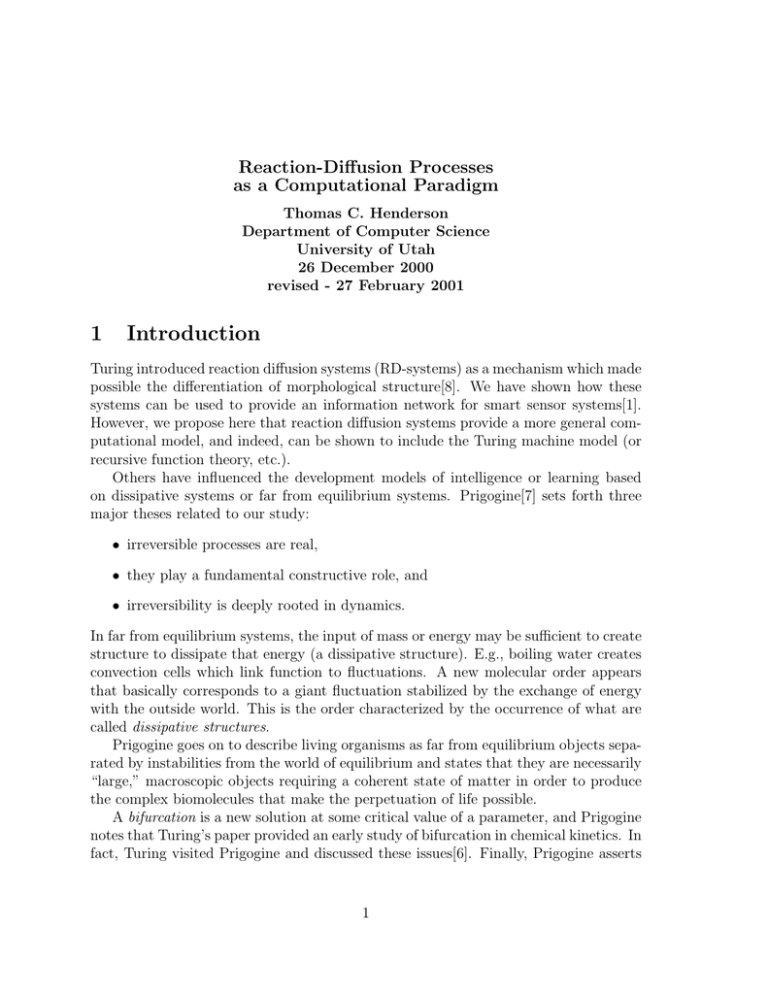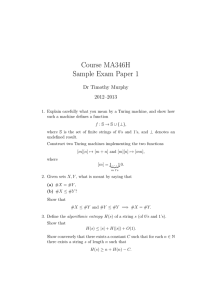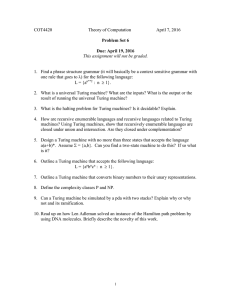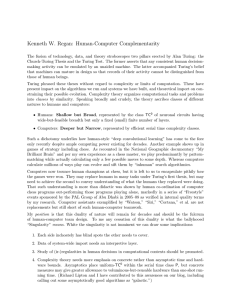Reaction-Diffusion Processes as a Computational Paradigm
advertisement

Reaction-Diffusion Processes as a Computational Paradigm Thomas C. Henderson Department of Computer Science University of Utah 26 December 2000 revised - 27 February 2001 1 Introduction Turing introduced reaction diffusion systems (RD-systems) as a mechanism which made possible the differentiation of morphological structure[8]. We have shown how these systems can be used to provide an information network for smart sensor systems[1]. However, we propose here that reaction diffusion systems provide a more general computational model, and indeed, can be shown to include the Turing machine model (or recursive function theory, etc.). Others have influenced the development models of intelligence or learning based on dissipative systems or far from equilibrium systems. Prigogine[7] sets forth three major theses related to our study: • irreversible processes are real, • they play a fundamental constructive role, and • irreversibility is deeply rooted in dynamics. In far from equilibrium systems, the input of mass or energy may be sufficient to create structure to dissipate that energy (a dissipative structure). E.g., boiling water creates convection cells which link function to fluctuations. A new molecular order appears that basically corresponds to a giant fluctuation stabilized by the exchange of energy with the outside world. This is the order characterized by the occurrence of what are called dissipative structures. Prigogine goes on to describe living organisms as far from equilibrium objects separated by instabilities from the world of equilibrium and states that they are necessarily “large,” macroscopic objects requiring a coherent state of matter in order to produce the complex biomolecules that make the perpetuation of life possible. A bifurcation is a new solution at some critical value of a parameter, and Prigogine notes that Turing’s paper provided an early study of bifurcation in chemical kinetics. In fact, Turing visited Prigogine and discussed these issues[6]. Finally, Prigogine asserts 1 that the origin of life is related to successive instabilities somewhat analagous to the successive bifurcations that have led to a state of matter of increasing coherence. Some similar ideas have been proposed by Gregson[3] who studies the generation of sensory intensity as a response to a physically varying environment. He is most interested in the sequential dynamics of a system when it is: • not in static equilibrium, • locally entropy producing, • dissipative; that is, it uses energy and is irreversible, • quasi-closed, • such that small input changes don’t necessarily mean small output, and changes • strongly dependent on initial conditions. Gregson then looks for the simplest dynamical structure which might support a diversity of observable input-output relationships whose parameters are potentially interpretable. Another interesting view is proposed by Kelso[4] in which locomotory patterns are explained by non-equilibrium dynamics though: • stability theory • bifurcation theory • fluctuation theory rather than through an appeal to formal programs of instructions in Turing machine format. He conceptualizes living systems and their component subsystems and their characteristic processes as ensembles of coupled and mutually entrained nonlinear oscillators. For Kelso, the problem is not: • How the mind operates on sensory data; • How past experience can interpret and give meaning to sensory data; • How brain processes or organizes input of nerves. The problem is rather: • How perceptual systems resonate to new macroscopic qualities. 2 (Also, see Gallistel[2] for interesting observations concerning coupled oscillator systems.) What is presented in this report is not so much a more detailed version of these ideas, but rather a simple mechanism for the implementation of these theories. 2 Restricted RD-Systems and Turing Machines An RD-system is defined by a set of equations that captures the reaction and diffusion aspects of certain chemical kinetics: ∂c = f (c) + D∇2 c ∂t (1) where f (c) describes the reaction and D∇2 c expresses the diffusion component. The simplest such systems have two morphogens or variables; one of these acts as the activator and the other acts as the inhibitor. The two variable system can be modeled by: ∂v ∂u = γf (u, v) + ∇2 u, = γg(u, v) + d∇2 v (2) ∂t ∂t where u and v are the concentrations of the morphogens, d is the diffusion coefficient and γ is a constant measure of scale. The functions f (u, v) and g(u, v) represent the reaction kinetics. As an example, we have explored the generation of spatial patterns using the Thomas system of equations (Murray[5] describes this system in detail): f (u, v) = a − u − h(u, v), g(u, v) = α(b − v) − h(u, v) ρuv (3) 1 + u + Ku2 where a, b, α, ρ, and K are the positive reaction parameters. They define a domain in which Equations 3 become linearly unstable to certain spatial disturbances. This domain is referred to as Turing space where the concentrations of the two morphogens will become unstable and result in zebra stripe patterns. Turing also developed an automaton model of computation; it can be shown that for each Turing machine there is an equivalent grammar which generates the strings accepted by the automaton. These grammars include a set of re-write rules which defines how symbols are transformed by the grammatical rules to produce strings. Now, given a set of re-write rules, it is clear that they can be expressed directly as a set of chemical reactions. If we take the reaction rates to be 1, then this achieves the same computation given as the set of rules. If it is necessary to specify context in the sequence relation of the left had sides of rules, then that may be achieved by rewriting the rules with new symbols that indicate the relation. h(u, v) = 3 To go the other way, the same tack is taken; namely, consider only RD-systems with kinetic reaction rates of 1. Then each reaction formula may be written as a re-write rule. Thus, strings in the grammar are generated by the application of the chemical reactions. Any sequence constraints can be implemented either in the definition of the physics of molecular attraction or by specifying the spatial relation in the symbol names. 3 Usefulness This is an important observation because it allows us to build reaction diffusion systems from various non-digital components and yet the exact computation may be specified and an equivalent Turing machine determined. RD-systems may be much more robust in application than Turing machines, and this needs to be explored. However, the application in mind here is the development of intelligent systems. We believe that RD-systems provide a strong framework for the modeling of intelligent systems, and in particular, sensory-perception systems. The RD-system model also permits the interaction of such systems in more complicated ways to provide emergent behaviors. Information can be considered as energy, and can be manipulated as such. This may allow us a stronger method to implement intelligent, or adaptive at least, systems that are more like their organic counterparts: • Bio-systems may create dissipative information structures to handle the flood of sensory data. • The same model works across multiple scales and may allow loose coupling. • Motor control may be directly incorporated into the reactions. • The explanatory power of the model covers both biological and non-biological systems. • Direct physical implementation may be feasible. References [1] Yu Chen and Thomas C. Henderson. S-nets: Smart sensor networks. In Daniella Rus, editor, International Symposium on Experimental Robotics, pages 85–94, Honolulu, Hawaii, December 2000. [2] Charles R. Gallistel. The Organization of Learning. MIT Press, Cambridge, MA, 1993. 4 [3] Robert Anthony Gregson. N-Dimensional Nonlinear Psychophysics. L. Erlbaum Associates, Hillsdale, NJ, 1992. [4] J. A. Scott Kelso. Dynamic Patterns. MIT Pressd, Cambridge, MA, 1995. [5] J. Murray. Mathematical Biology. Springer-Verlag, Berlin, 1993. [6] Hans Othmer. Personal communication. 1994. [7] Ilya Prigogine. From Being to Becoming. WH Freeman and Company, San Francisco, CA, 1980. [8] Alan Turing. The chemical basis of morphogenesis. Philosophical Transactions of the Royal Society of London, B237:37–72, 1952. 5






